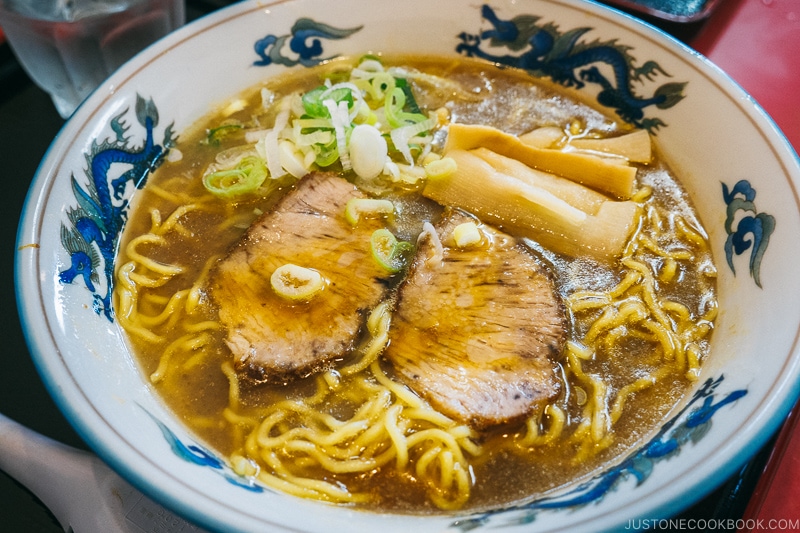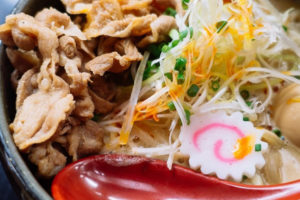This is your guide to the most popular types of ramen and how they are classified in Japan. You’ll also learn about its origin, how ramen has evolved and become one of the greatest dishes in the world, and more!
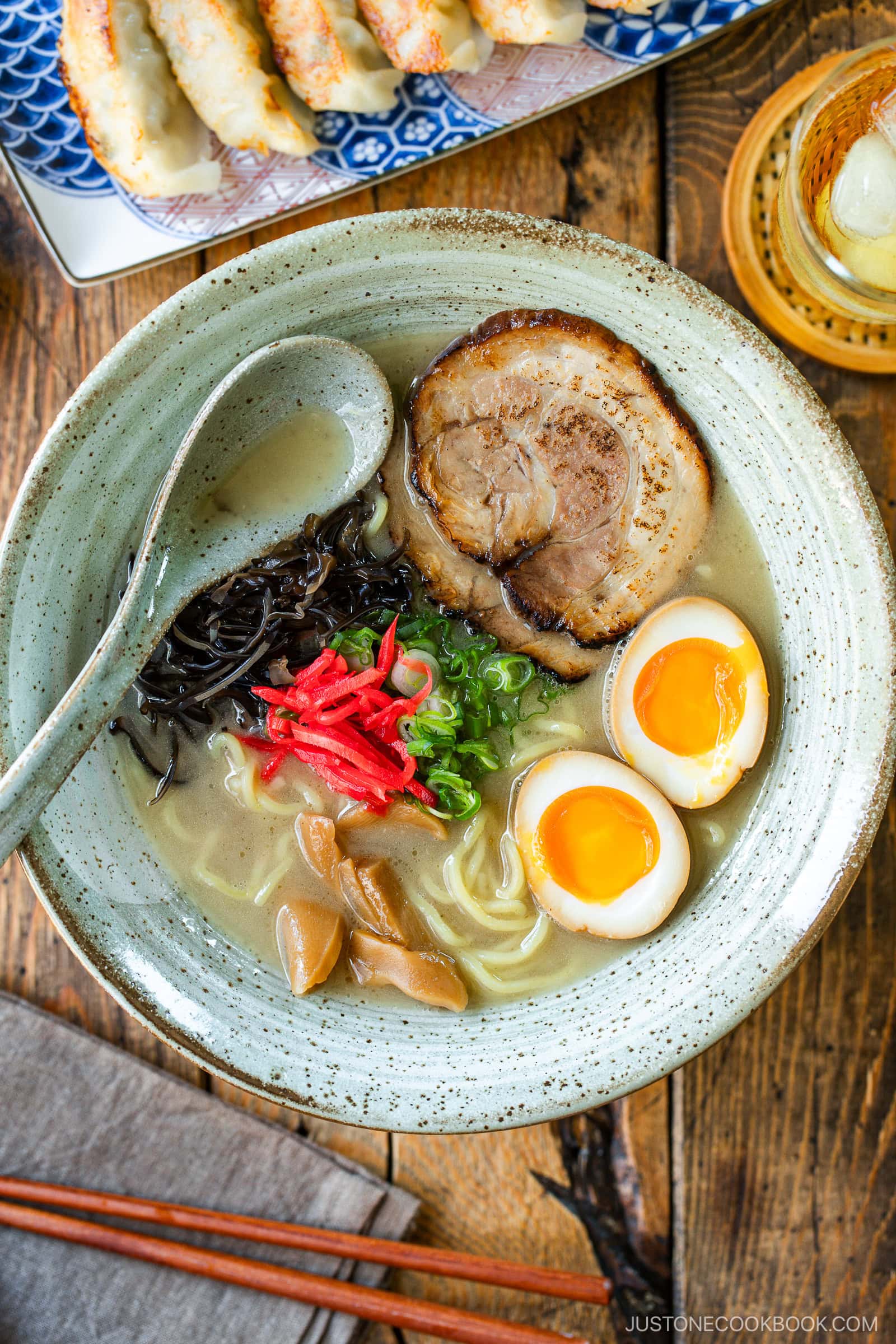
Hello, ramen fans! How many types of ramen have you tried? And what are some of your favorite bowls?
One would need to spend a lifetime trying out all the different styles of ramen available in Japan. Each ramen—defined by regional styles and specialties—abounds with soup stocks, noodles, and toppings, all varied based on local ingredients, tastes, and cultures. Even outside of Japan, the burgeoning of ramen has brought a severe ramen boom culture across the globe, expanding the realm of ramen beyond the traditional bowls.
While there’s an infinite world of ramen, we are here to demystify the different types of ramen you’ll want to know. Ready for your ramen adventure? Let’s dive straight into this Japanese ramen guide.
What is Ramen?
Ramen is a Japanese adaptation of the Chinese noodle dish called lamian (拉麺). It consists of long wheat noodles served in a soup broth with a variety of toppings. Meaning ‘pulled noodles,’ multiple etymologies are associated with ramen, and the classic ramen concept has significantly evolved and is still evolving.
Origin of Ramen in Japan: A Brief History
There are several theories about the origin of ramen in Japan. According to the Shin-Yokohama Raumen Museum, ramen was introduced to Japan at the end of the Edo period by the influx of Chinese immigrants who settled in Yokohama, Kobe, Nagasaki, and Hakodate. The expansion of Chinatowns (also called Nanjing towns) in these port cities opened a floodgate for Chinese cuisine that is to become a distinct part of Japanese food culture, known as chuka ryori.
In 1910, the first ramen shop, Rairaiken (来々軒), was opened in Akasusa, Tokyo. The main menu was “Nankin soba,” named after Chinatowns and soba noodles. These noodle dishes spurred the popularity of ramen throughout Japan, which ramen critic Hiroshi Osaki calls “the first year of ramen.”
Following the success of Raitaiken, more Chinese restaurants opened, and ramen became a standard menu item along with dumplings, fried rice, and shumai. Over the years, ramen has developed and transformed into a uniquely Japanese noodle dish.
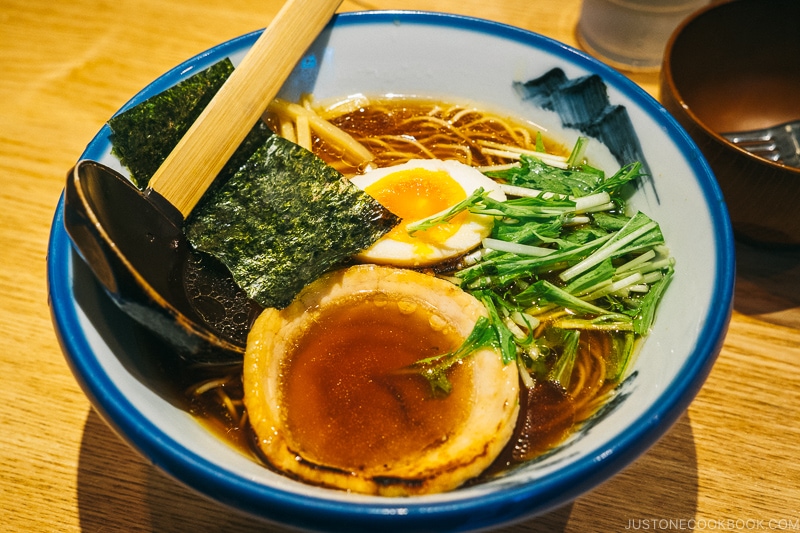
Ramen Today: Global Popularity
Today, ramen is not only the soul food of Japan, but its popularity also spans the globe as one of the most influential foods internationally.
The ramen craze phenomenon partly has to be credited to inventor Momofuku Ando, who solidified ramen’s reputation by developing the world’s first instant ramen, “Chicken Ramen,” in 1958. By the late 20th century, instant noodles had spread worldwide, and big Japanese ramen chains, such as Ippudo and Ichiran, started to expand globally and push the standard of quality Japanese ramen.
Since then, the noodle dish has come in many forms, from the cheap fast food in a cup to the Michelin options. In Japan alone, you can find over 32,000 ramen shops, countless hidden behind train stations and department buildings, or tucked in inconspicuous alleyways. In the U.S., we have David Chang and Ivan Orkin, who popularized ramen in their endeavors.
Ramen shops in Japan are simple eat-and-go restaurants, not places to linger long after your meal. They usually have counter seating, where you buy a meal ticket at the entrance and hand it to the staff.
What Goes into Ramen: Soup, Noodles & Toppings
Before we get to the ramen types, let us first take a quick look at what makes up a bowl of ramen:
1. Ramen Soup Broth & Tare
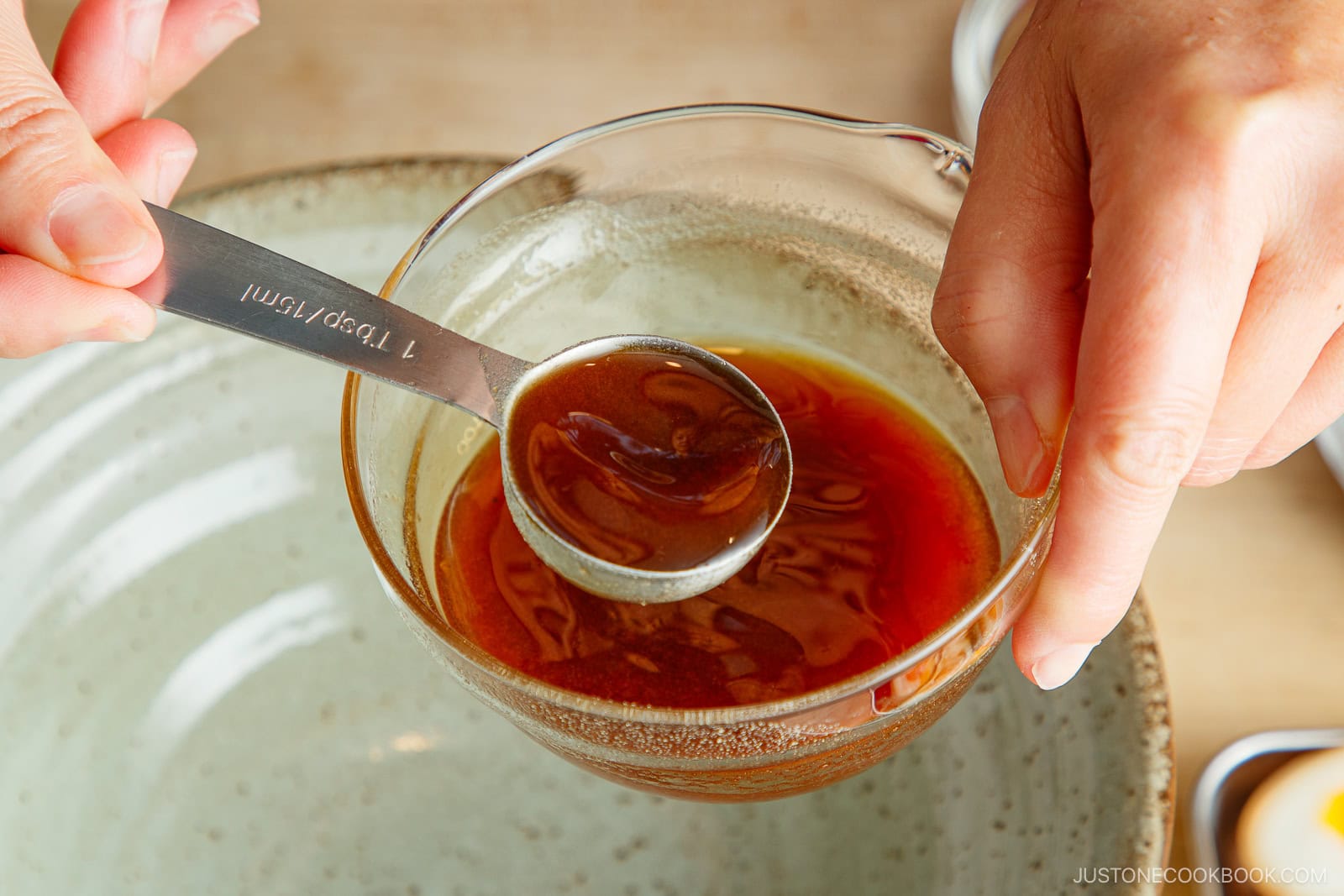
As one would expect, soup is the elemental factor that determines the greatness of a bowl of ramen. Ramen masters put a great deal of effort into concocting their soup.
- Soup Broth – The soup broth is the base, which is made from umami-rich ingredients such as pork or chicken bones, dried seaweed, seafood, charred vegetables, lard and fats, and aromatics.
- Tare (Sauce) – Tare, or the sauce, defines the critical flavor of ramen. There are three primary tare: Miso, salt, and soy sauce. They can be combined with other seasonings such as mirin, sake, sugar, spices, or bean paste to create a rich sauce that will complete the soup broth.
2. Ramen Noodles: Types & Texture
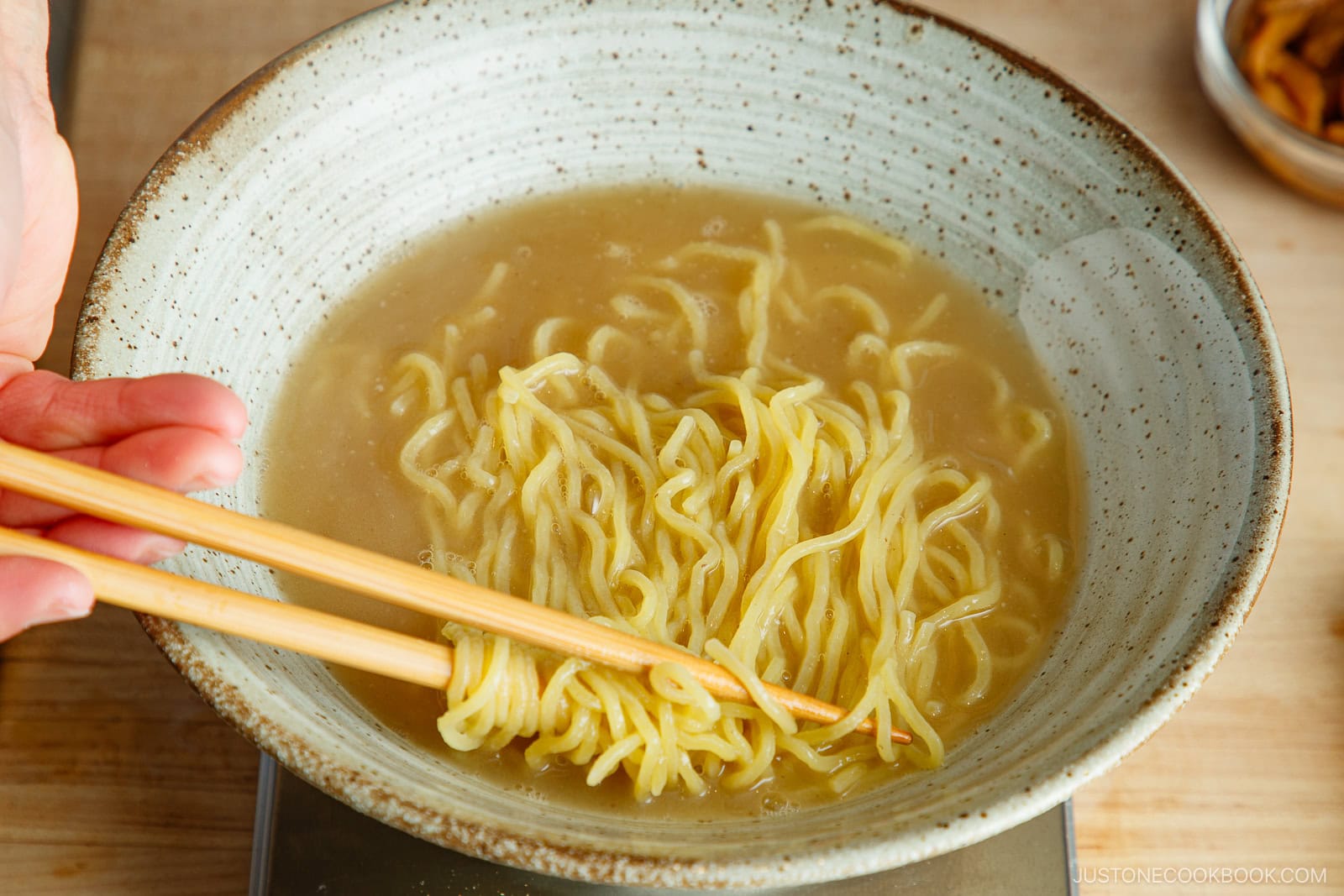
Another major component of ramen is noodles. Ramen noodles, also called soba (not to be confused with buckwheat soba), are made of wheat flour, salt, water, and kansui. Kansui, an alkaline solution, gives ramen its distinct yellow tint and springy texture.
The noodles can be straight, wavy, or of varying thickness. Pay attention to the ramen packaging, and you’ll spot numbers like no. 18, 20, 22, 24, 26, and 28, which tell you the noodle cut.
3. Ramen Toppings: Classic & Popular Choices
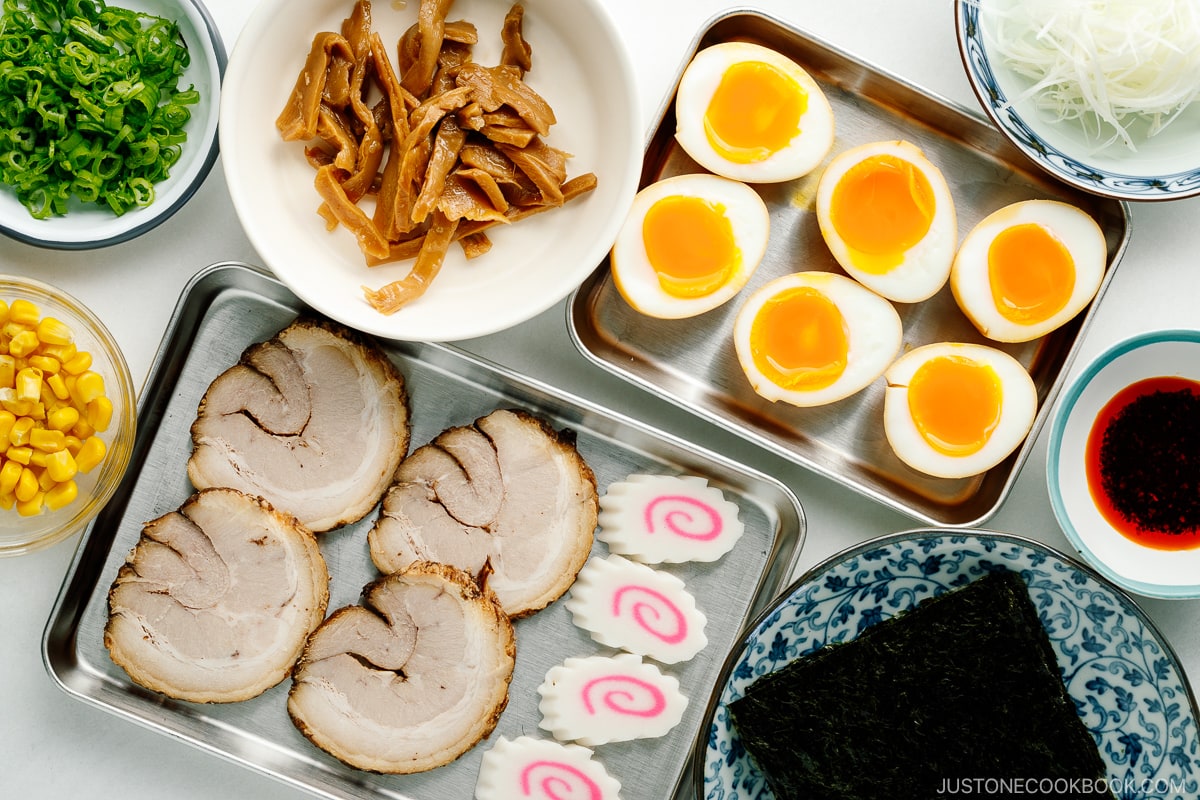
The last component is toppings. The options are endless, but the standards are tender chashu slices (simmered pork belly or pork shoulder), soft-boiled eggs, AKA ramen eggs, menma (bamboo shoots), nori sheet, bean sprouts, narutomaki fish cake or kamaboko, and negi scallions. Lastly, you can sprinkle sesame seeds, shichimi togarashi, la-yu chili oil, or grated garlic or ginger for an extra punch of flavor.
The combination of ingredients sometimes defines a unique style of ramen, and there is no-frills ramen that doesn’t come with toppings.
Read: Best Toppings to go with Your Homemade Ramen
Types of Ramen: Complete Guide
By Tare (Seasoning Sauce)
When you go to a ramen shop or ramen-ya in Japan, you’ll often see ramen being categorized by the type of tare (sauce) used in a particular bowl. The three primary tare flavors are shio (salt, 塩), shoyu (soy sauce, 醤油), and Miso (fermented soybean paste, 味噌). These are the building blocks to develop different styles of ramen.
Shio Ramen 塩ラーメン
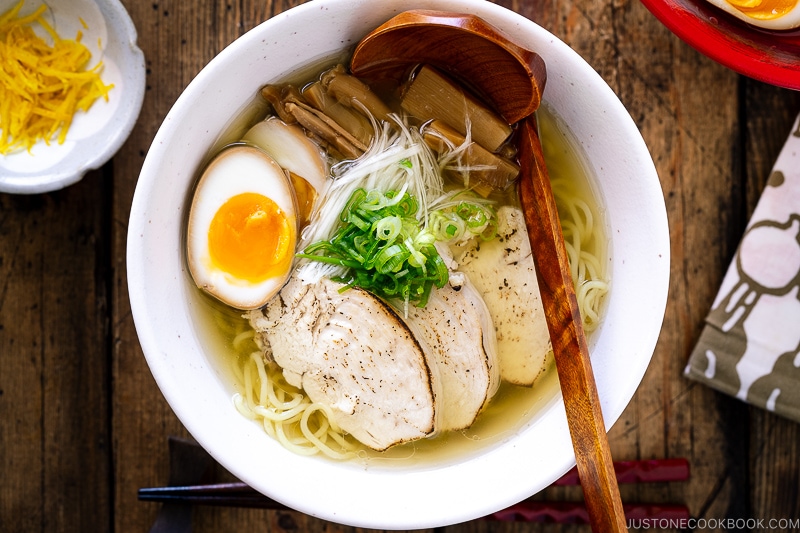
Shio means salt, so shio ramen is seasoned simply with salt tare. The soup is clear, delicate, and light as it is simmered more slowly to concentrate the flavor and prevent cloudiness. The broth is often made with chicken broth (sometimes with the addition of pork bones) and flavored with dried sardines, dashi stock, bonito flakes, seaweed, and vegetables.
Light-colored to the point of almost translucent, shio ramen is salt-based ramen broth. It’s also the lightest in terms of oil, as it is boiled down to concentrate the flavor. Ramen shops would then dress the broth with chicken, seafood, seaweed, and pork bones.
🍜 Get our Shio Ramen recipe!
Shoyu Ramen 醤油ラーメン
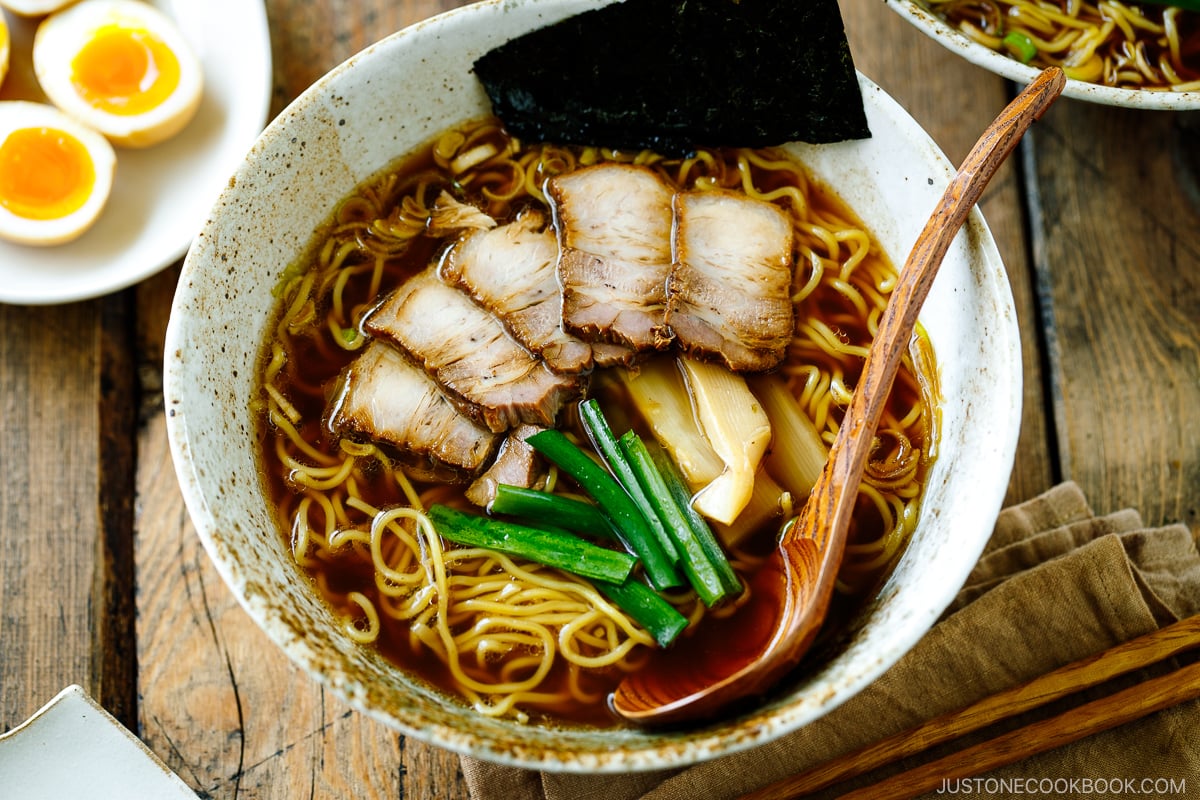
Seasoned with Japanese soy sauce, shoyu ramen tastes slightly more complex than shio. The broth could partake a clear brown color that’s light on the tongue or a dark cloudy color that’s dense and rich, depending on what is additionally swirled into the broth.
Shoyu ramen— also called Tokyo Ramen —is the original Tokyo-style classic that reminds many of mom’s homemade ramen or that nondescript ramen shop from childhood.
🍜 We have two versions of shoyu ramen on the blog: Shoyu Ramen from Bizentei and Nami’s Spicy Shoyu Ramen.
Miso Ramen 味噌ラーメン
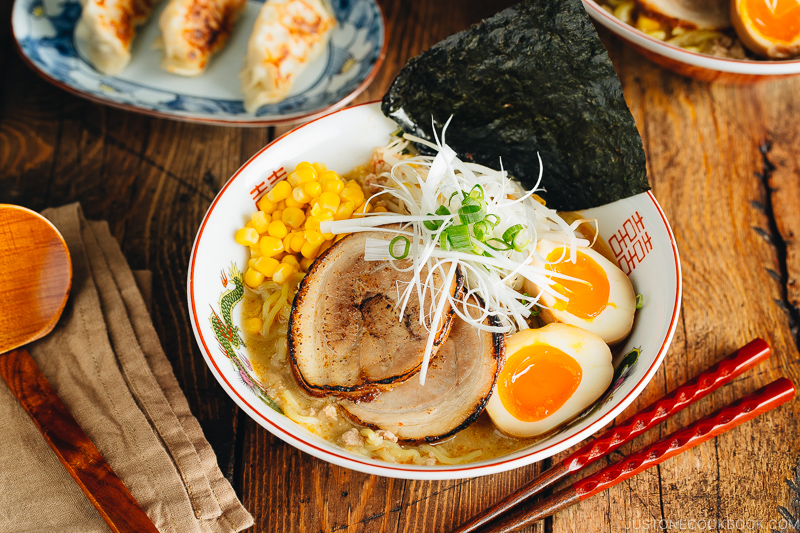
The most umami-rich and heaviest of the three types, miso ramen is known for its deep richness and bold flavor. It originates from the northern island of Hokkaido, but its popularity has spread across the country, where there are as many miso ramen broths as there is miso.
🍜 Get Nami’s Highly Rated Miso Ramen Recipe.
How about Tonkotsu Ramen and Tori Paitan?
Interestingly, tonkotsu ramen (豚骨ラーメン) has received such widespread popularity in the U.S. and other parts of the world that it is often classified as the fourth type of ramen. However, we want to clarify that tonkotsu is not tare but a type of soup broth, and it might surprise you that it has lost its popularity over the past decade in Japan.
Taking over the rank is tori paitan (鶏白湯), a thick and milky chicken-based soup broth. It’s especially among women who try to get extra collagen from the soup.
So, to be technically correct, we consider both tonkotsu ramen and tori paitan by soup categories instead of grouping them as the tare flavors. Let’s discuss the soup categories more.
By Dashi Soup Stock
Besides tare (sauce), Japanese ramen experts also classify ramen by the types of soup stock. Called “dashi” in the ramen language, the soup stock plays the core part of ramen. There are two types of soup stock: Chintan soup and Paitan soup.
Chintan Soup (清湯スープ)
This soup broth is used to make the shoyu, shio, and miso ramen discussed above. Chintan soup is clear and thin and made with pork, chicken, or both bones, vegetables, and seafood. The soup stock is boiled down over low heat to prevent it from becoming cloudy, resulting in a clear soup.
Because of its light flavor, chintan soup is almost always made with traditional Japanese dashi ingredients. Combining the unique and umami-loaded flavors in dashi with pork or chicken soup broth will give you a real Japanese food experience. These umami-imparting ingredients are:
- Katsuobushi
- Dried anchovies (niboshi) and ago (pronounced ‘agoh’)
- Kombu
- Dried shiitake mushrooms
Paitan Soup (白湯スープ)
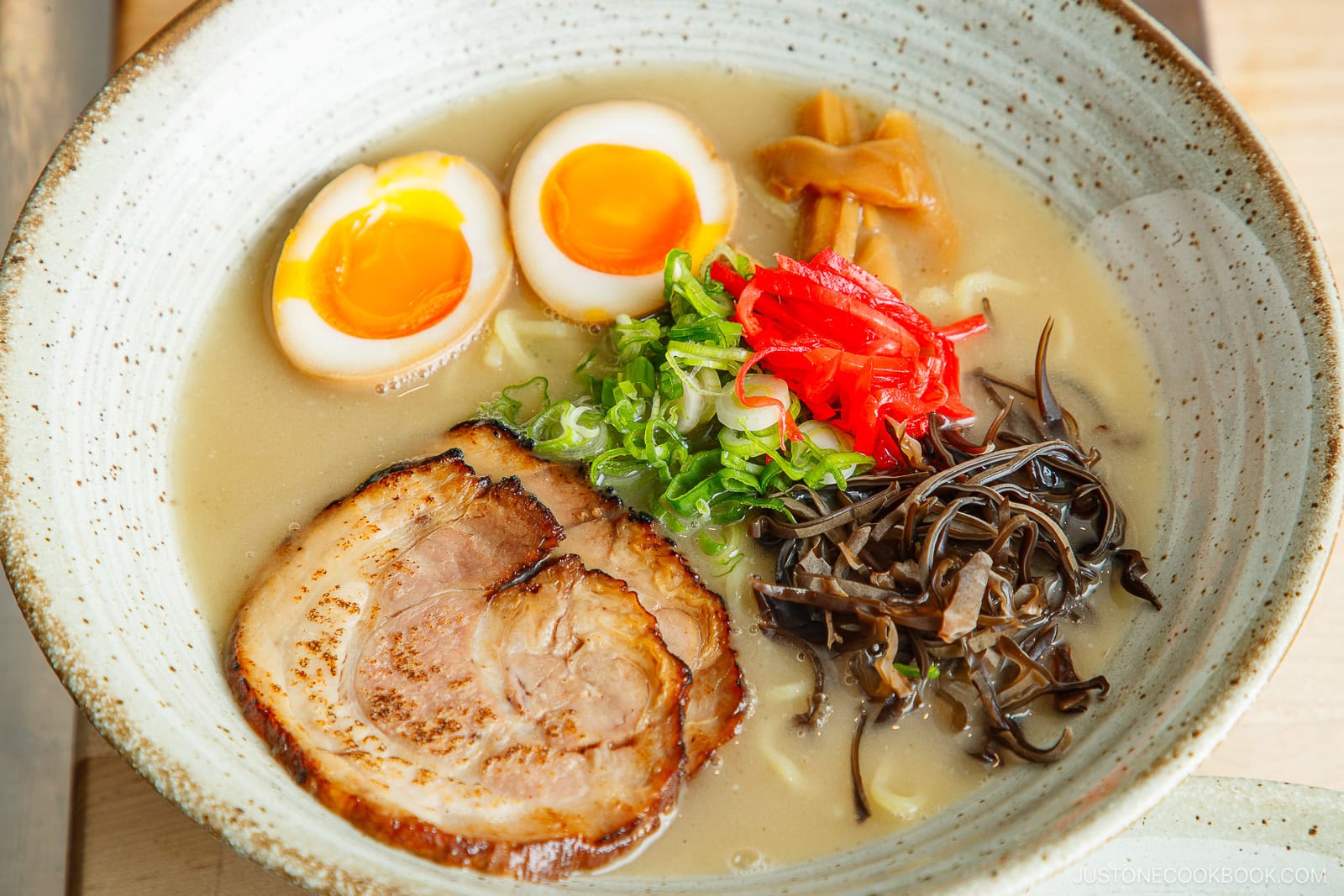
Tonkotsu ramen and tori paitan ramen fall into this category. Paitan soup is thick, rich, and creamy, made by boiling pork bones (for tonkotsu) or chicken bones (for tori paitan) over high heat for 8–10 hours. The vigorous boil breaks the bones apart and creates an emulsion, resulting in a concentrated, cloudy broth packed with umami.
- Tonkotsu Ramen – Tonkotsu ramen (豚骨ラーメン) is one of the richest styles, made with a creamy, complex pork bone broth. Outside Japan, many people treat it as the “fourth type” of ramen, but in Japan, tonkotsu refers to the broth itself—not the flavor.
- Tori Paitan Ramen – Tori paitan (鶏白ラーメン) features a chicken bone broth seasoned with shio or shoyu. The long, high-heat simmer of chicken bones and breast meat creates its cloudy white soup. Rich yet lighter than tonkotsu, this broth offers a deep flavor without the heaviness.
Note:
- Tokyo Ramen Tours shares that tonkotsu was invented by accident. In Fukuoka, a chef let pork bones boil for hours longer than planned, creating a cloudy, collagen-rich broth bursting with flavor. Diners loved it, and this happy mistake gave birth to one of the world’s most famous ramen styles.
- Some ramen shops add salt or soy sauce tare to their tonkotsu or tori paitan, creating menu items like Tonkotsu Shoyu Ramen, Tori Shio Paitan Ramen, or Tori Paitan Shoyu Ramen. Even with “shoyu” in the name, the broth stays milky and opaque—unlike classic shoyu ramen, which is dark brown and clear.
By Toppings
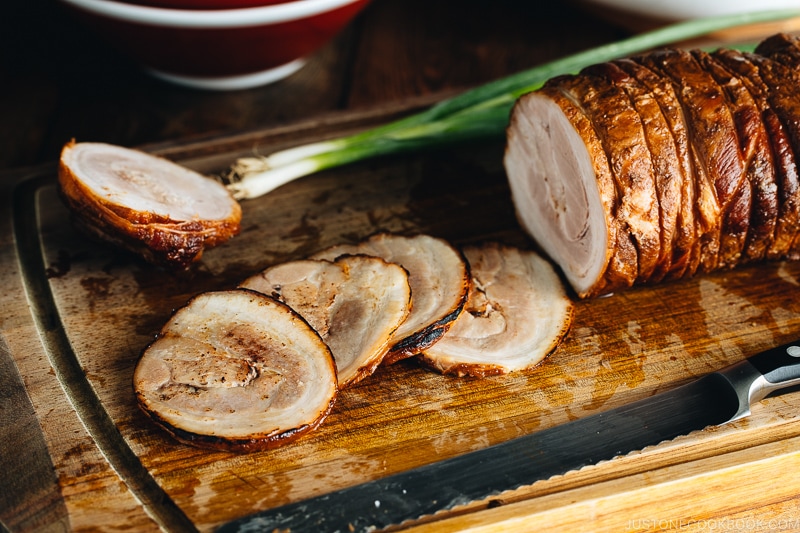
Another classification is by toppings. You can generally tell it by the name of ramen. The toppings can be just one ingredient or a mix, but they become the dish’s focal point.
Chashu Ramen チャーシュー麺
Chashu ramen highlights the delicious sliced pork on top. Some ramen shops specialize in offering chashu—braised or grilled chicken or pork. As it is the main star of the ramen, you get extra slices in the bowl.
Negi Ramen ネギラーメン
Negi means green onions, and traditional negi ramen comes piled high with sliced negi. Every slurp is a mix of soup, noodles, and green onion.
Wonton Men ワンタン麺
Seeking more carbs in your bowl? Go for wonton men, ramen with slippery wonton.
Regional Variations
1. Hokkaido Ramen (Hokkaido)
Hokkaido has three popular regional ramen types that are well-known throughout Japan.
- Sapporo Ramen (Miso) – This regional specialty ramen is as famous as Sapporo beer. It features curly medium-thick noodles with sliced meat, vegetables, and notably a pile of sweet corn and a big slab of butter. The hot soup broth comes in soy sauce, salt, or miso flavors, but miso ramen is the most popular. The rich and bold-tasting miso soup has a lot of lard that keeps it from getting cold.
- Asahikawa Ramen (Shoyu) – Complex and rich tasting, Asahikawa ramen is another famous ramen from Hokkaido. The soup stock, known as double soup, combines pork bones with dried sardines. You can see the fatty sheen on top of the soup as it keeps it warm for a longer time, which is excellent for long, cold days.
- Hakodate Ramen (Salt) – Hakodate’s salt ramen stands out for its delicate flavor and low oil content. Hakodate is close to the sea, but almost no ramen shops use seafood in their soup stocks for some reason.
2. Kitakata Ramen (Fukushima)
Fun fact: Kitakata City in Fukushima Prefecture has one of the highest ratios of ramen shops to population in Japan. Ramen is the staple food in the area, and many people eat it for breakfast before heading to work.
Ramen features locally made thick noodles with high water content, crafted with the region’s famous spring water. Because of its tasty noodles, ramen bowls often come with a large portion of noodles.
3. Hakata Ramen (Kyushu)
Originating in Fukuoka, Hakata ramen is very similar to tonkotsu ramen. It features ultra-rich, milky white tonkotsu soup broth with thinner noodles and minimal toppings. Hakata ramen often uses tare sauce like miso, shio, or shoyu, but chefs usually leave it plain to spotlight the robust broth.
Hakata ramen is what most people think of when they hear pork bone ramen, and it is one of the most famous local ramen dishes in Japan. Since the noodles are skinny and stretchy, most restaurants serve only a tiny portion to prevent the noodles from becoming soggy.
If you crave more, instead of ordering another bowl, ask for refill noodles by saying ‘kae-dama kudasai,’ (替玉), which means ‘more noodles, please.’ The ramen chef will directly serve another portion of noodles in your finished bowl. You might be able to find Hakata ramen internationally, as the Ippudo ramen shop offers it on its global menu.
Creative & Modern Ramen Styles
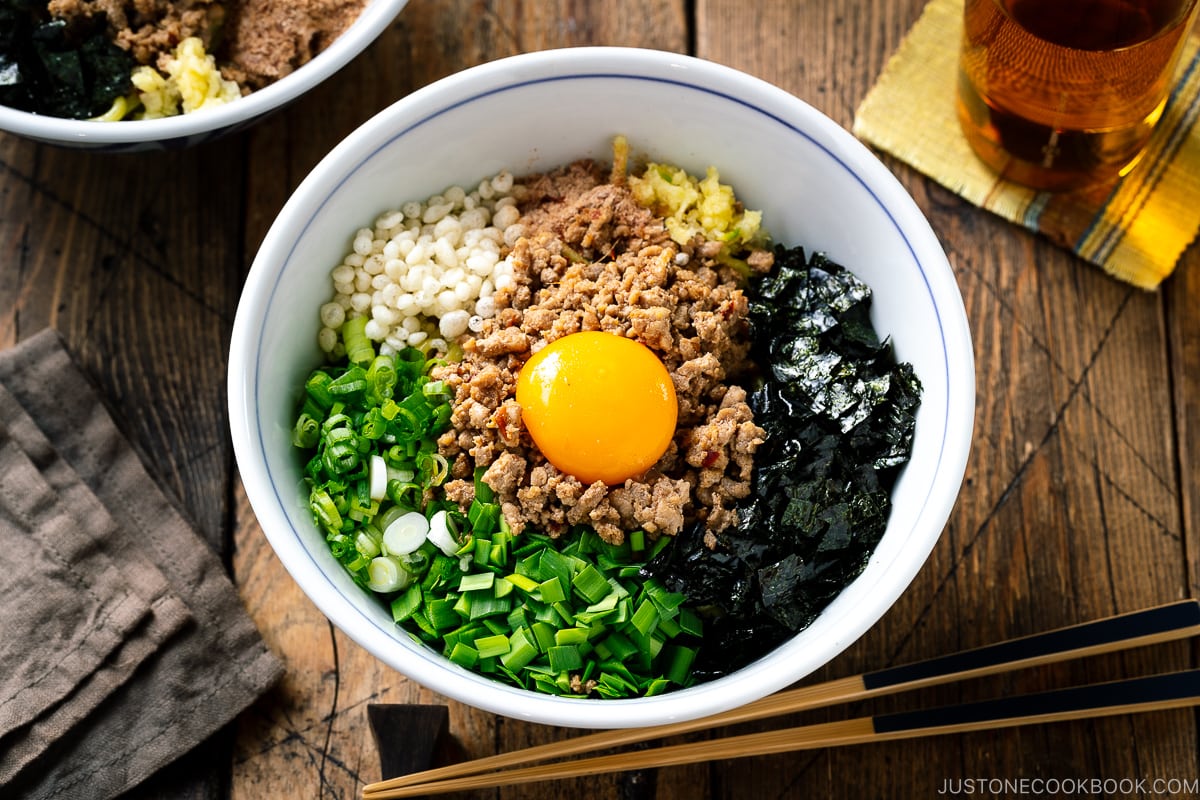
Now, we come to a completely different league of ramen that doesn’t fit into the above categories. They have unique features and characters, such as Tsukemen, Mazesoba (Mazemen), Okinawa soba, and Abura soba. Some dishes use the wavy noodles in different forms, such as yakisoba and hiyashu chuka, which is another story.
Some ramen shops expand their repertoire to include gluten-free, halal, and vegan ramen. While not commonplace, ramen masters are taking note of the changing demands of their hungry customers.
Did you enjoy this ramen guide?
We hope this Japanese ramen guide has stirred your curiosity and your senses! In the comments below, please share your favorite style of ramen and local ramen shops.


